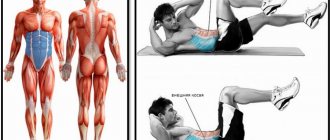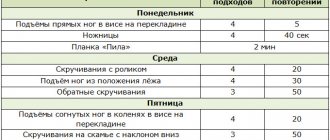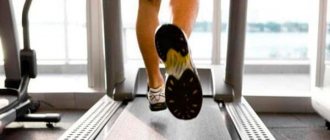At first glance, it seems logical to say that in order to get ripped abdominal muscles, you need to perform appropriate physical exercises several times a day. However, if you study in more detail the question of whether it is even possible to train your abs every day, the likelihood of getting an unpredictable answer is extremely high.
The need to follow certain rules related to the frequency and timing of exercises to work out the muscles in the abdominal area is determined by the physiological characteristics of the human body. We are talking about the importance of the period of recovery of muscle fibers after physical activity for the general condition of the athlete, as well as its local transformation.
The article below contains detailed information about how many times a week you should train your abdominal muscles, what time of day is best to do this, and also when it is better, at the beginning of a workout or at the end of it, to devote time to such “pumping.”
Is the frequency of abdominal muscle training important?
The frequency of abdominal muscle training is extremely important to achieve results.
With a competent approach to building a training system, paying special attention to the question of how often you can do abdominal exercises, an athlete will be able to achieve a visible transformation of his figure after 2-3 months of regular work on his own body.
Important! You should not expose yourself to complex physical activity more than once a day. Neglecting this recommendation will most likely lead to muscle exhaustion and psychological discomfort for a person who ultimately strives to obtain pumped abdominal muscles.
The frequency and frequency of training are directly related to the physical preparation of the athlete, his initial data, as well as the specific results he wants to achieve (“drawing” cubes on the stomach, flat surface, eliminating sagging, tightening the muscle corset, and so on).
In accordance with similar criteria, the “working” number of repetitions is determined, or how many times a person needs to pump the abs in one approach in order not only to strengthen the muscles, but also to transform the stomach, giving it the desired appearance.
Be sure to watch: Making a slim waist and tightening your abs: exercises and tips A set of exercises for the abs and legs: a set of workouts for muscles, buttocks, thighs Details on how to properly pump up your abs to remove belly fat How to pump up your oblique abdominal muscles: basic exercises
Exercise and subcutaneous fat
The choice of abdominal exercises also plays an important role.
You can do dozens of body lifts and twists, but still not get a visible result. Among other things, this approach can lead to back pain and muscle imbalance.
Instead, I recommended doing stability exercises that work the core muscles from all sides (planks, bird and dog exercises).
It is very important to get rid of fat deposits throughout the body, and not just on the stomach, only in this case the tummy will be prominent.
This is why isolated ab workouts don't work for fat loss.
Why?
The abdominal muscles are relatively small in size. They don't require a lot of calories to work properly, which means that training solely on your abdominal muscles won't have much of an impact on your overall body fat.
Such workouts will not even remove belly fat. And numerous studies provide direct confirmation of this.
You need to train so that fat is burned specifically around the working muscle, otherwise the body will break it down where and how it is convenient for it. The specific order and amount of fat the body uses is determined by gender, genetics, the presence of various chronic diseases and a number of other factors.
This doesn't mean that abdominal workouts are useless. These muscles are vital for performing all daily activities and maintaining balance. We need them to be strong.
And even if you don’t care about your strength, but only about the appearance of your abdominal muscles, then the first thing you will do is train these muscles.
Think about it:
If you lose all the excess fat but don't gain muscle, will your six pack still show?
No. You will simply have a flat stomach because without proper muscle training, they will not become noticeable.
Is it possible to train every day and what will happen if you do it often?
Qualified specialists, whose line of work is inextricably linked with “pumping up” the human body through physical activity and proper nutrition, spent a lot of time analyzing reliable information on the question of whether it is necessary to pump up the abs every day in order to speed up the process of its transformation.
As a result of research in the field of physiology and characteristics of the human psyche, they came to the consensus that this is absolutely impossible to do.
Important! This conclusion is based not only on the ineffectiveness of such an approach to giving relief to the abdominal muscle corset, but also on the existence of a risk of causing irreparable damage to the health of one’s “ward.”
By not allowing the muscles to recover, the athlete creates a greater likelihood of uneven growth of muscle fibers on the stomach and back.
Due to the rapidly increasing load, the muscles that hold the spine become thinner and provoke the occurrence of stoop, protrusions of intervertebral discs, hernias and even displacement of the vertebrae themselves in a person who neglects the recommendations of specialists on how often to pump up the abs.
Moreover, by exercising more often than the situation requires, the athlete increases muscle mass without getting rid of subcutaneous fat. It is for this reason that after such training the stomach visually appears even larger.
If arguments proving to a person why it is impossible to pump up the press every day, from a physiological point of view, are not enough, it is worth mentioning the psychological component of this issue. By exercising several times a day every day, the athlete does not allow himself to rest mentally, which directly affects his drive in achieving the final result.
You may also be interested in: How many times a week to exercise
What is a press?
There is no such thing as “abs” in anatomy. This is the conventional name for the abdominal muscles. There are four of them: straight, internal oblique, external oblique and transverse.
The rectus abdominis muscle is the largest in area, it is paired and consists of vertical longitudinal muscle bundles. Contrary to the misconception that there are “lower” and “upper” abs, the rectus muscle does not have such a division. The notorious “cubes” stand out due to the tendon jumpers on the rectus abdominis muscle.
The muscle bundles of the external abdominal muscle start from the lower eight ribs and go down radially, the internal oblique muscles are located respectively inside of the external ones. The transverse muscle is located deeper than the other abdominal muscles. In this case, its tendon stretch in the upper two thirds passes behind the rectus muscle, and in the lower third - in front. Partly because of this, the lower “cubes” of the press are less amenable to training than the upper ones.
How often can you exercise per day and week?
Having figured out for yourself whether it is worth exposing your body to such physical activity every day, and also what will happen if you neglect the rule and vigorously pump your abs every day, it is advisable to understand another topic. We are talking about exactly how many times you need to work your abdominal muscles per day or week to achieve a quick effect.
You can pump up your abs every day once for the maximum number of repetitions, only if there is a need to urgently strengthen the muscle corset in the shortest possible time, without getting rid of excess fat (an option for professional athletes who have a minimum amount of subcutaneous fat).
Important! To avoid harm to human health, it is permissible to use such a technique only periodically, and not on an ongoing basis.
The safest and most effective method is considered to be performing a comprehensive abdominal workout 3-4 times a week. It is this amount that can be considered optimal for thoroughly working out the abdominal muscles with the possibility of natural restoration of the muscle corset.
What happens if you pump up your abs every day? Consequences of overtraining
Due to its simplicity and effectiveness, abdominal crunches are one of the most common exercises. With regular training, the result is guaranteed - you just need to be patient and practice. However, many try to speed up the process of the appearance of the coveted cubes by intensely pumping up the abs on a daily basis. Does this approach really help you achieve results faster, or can continuous training lead to unpleasant consequences? Let's figure out what will happen if you pump up your abs every day.
What to eat to pump up? 10 Simple Foods to Gain Muscle Mass
Food can be not only tasty, but also effective.
What are the dangers of overtraining?
Any load must be dosed. During training, microtraumas occur in muscle fibers, which take time to heal. It is during the recovery process that muscle volume increases. If you do not give your muscles the necessary time to overcome the consequences of microtrauma, then there is a high risk of overtraining. This condition occurs when cells do not have time to adapt to stress, biochemical processes are disrupted, immunity is reduced and the central nervous system is overstrained.
Overtraining leads to a decrease in the effectiveness of training, a slowdown in progress, or even a rollback from the achieved results. Continuing to train in this state is not only useless, but also dangerous to health, since fatigue accumulates in the body against the background of chronic under-recovery.
Photo: istockphoto.com
How long does it take for abdominal muscles to recover?
So, when wondering whether it is possible to pump up the abs every day, you need to understand how much time it takes for the muscles to absorb the resulting load. It is a common belief that due to their small size, the abdominal muscle group needs less recovery time than the back or leg muscles. However, most experts call such beliefs a myth, since the biochemical composition of the abs is no different from other muscles. In addition, the abdominal muscles are involved in many exercises on other parts of the body, so the load on them is increased.
Photo: istockphoto.com
On average, it takes 48 hours for muscles to recover after physical activity. But in each specific case, these indicators vary, since they depend on the intensity and duration of the workout.
How to do strength training at home? Rules to help keep your muscles toned
We study the intricacies of fitness. Progress depends on them!
How often can you train your abs?
- Strength training for the abs using heavy weights is recommended for people of beginner and intermediate levels of training twice a week.
- Long endurance training with high repetitions can be done 3-4 times a week.
- Individual abdominal exercises without additional weight and a large number of repetitions can be done more often, but experts still recommend resting the muscles once every three days.
Photo: istockphoto.com
Thus, full-fledged abdominal workouts should not be done more than four times a week, since the muscles will not have time to digest the resulting load, and the path to the desired result will become noticeably more difficult. With standard abdominal crunches for morning exercises, the load on the abdominal muscles is not so high, but these exercises should not be performed every day.
The desire to pump up the abs as often as possible can be explained by the desire to quickly see the results of working on oneself, however, performing exercises on the abdominal muscles every day is fraught with injuries, fatigue and muscle regression.
When is it better to work the abdominal muscles at the beginning or end of a workout?
In addition to figuring out how often it's appropriate for men and women to engage in targeted ab training, it's important to understand the best time to do it: at the beginning or end of a workout.
Despite the widespread opinion that it is impossible to properly work out the abdominal muscles after intense training, the vast majority of professionals are confident in the opposite.
Experienced fitness trainers build a training program for their “trainees” in such a way that they need to pump up their abs after completing the main stage of the complex.
In their opinion, it is impossible to work with the abdominal muscles at the beginning of training for two reasons:
- the intensity and quality of strength training decreases significantly;
- During the main part of the workout, the risk of injury to the back increases, in particular to the lower back, which is often overstrained during abdominal exercises.
Why do we need abs?
The abdominal muscles belong to the so-called core muscles, a complex of muscles responsible for stabilizing the spine, pelvis and hips. Each of the abdominal muscles is responsible for its own functions. The rectus muscle is for twisting the body in the lumbar region, the external oblique muscle is for rotating the body in the opposite direction, flexing the spinal column, and is involved in the contraction and expansion of the chest. The internal oblique muscle is responsible for the same functions as the external oblique, but is responsible for rotating the body in the other direction. The abdominal muscles, together with the muscles of the lumbar back, allow you to maintain posture, participate in the respiratory process, and in women they play an important role during childbirth.
What time of day is best to do exercises: morning or evening, before bed
In order to minimize negative interference in the body's biological rhythms when working on the abdominal muscles, the athlete should also consider when it is better to do such exercises: in the morning or in the evening.
Whether it is possible to pump up the press at night, or as soon as a person wakes up, depends solely on his daily routine and the surge of vigor and strength. For example, if an athlete is a “night owl” (wakes up and falls asleep late), it would be optimal for him to work on his body in the evening, during the peak of his activity.
Important! When asked whether it is possible to exercise before bed, professionals unanimously answer in the negative. Such physical activity can overstimulate the body, resulting in insomnia, fatigue, lack of sleep, and so on.
Do you need to work out your abs every day to achieve six-pack abs?
Many people play sports and most of them want to get pumped up. Of those who want to improve their physical fitness, namely to pump up muscles, not everyone wants to develop their entire body and its muscles.
Coming to the gym, many people purposefully go to train some particular part of the body, for example, 45 cm biceps, less often the back, and even less often the legs. But the leaders in this marathon are always the cubes. And when you hear the question: is it possible to pump up the press every day, then there is no doubt. This person is interested in pumping up his abdominal muscles and nothing more. I personally and most people who engage in bodybuilding at the amateur and professional level believe that you should always train in a complex manner.
Although I am not a supporter of local pumping and I think this is not the right approach. Nevertheless, in this article I will try to answer the question of whether it is possible to pump up the press every day. Is it worth doing this at all, are there any alternatives and prospects for this approach. And how often should you pump up your abs? I’ll also try to answer this question.
Most programs found online consist of a set of targeted exercises: lying on the floor sit-ups, leg raises, variations of these exercises to the side, and so on. And it is advised to pump up your abs in them every day. That is, using these methods you need to bomb your abdominal muscles with a whole set of essentially local exercises. But is it really possible to pump up your abs every day?
Most of them are designed to pump up abs at home. People with an analytical mind will immediately ask the question, why at home? You can answer that in the gym you can pump up your abs every day with a different set of exercises. Such as: working on a wall bars, lifting the body on a Roman chair instead of the floor. Although I see the main difference is that it is possible, or rather necessary, to pump up your abs at home and in the gym, not with different exercises or equipment, but with different approaches to methodology in general. But again, let's not go deeper into this issue. After all, this is a topic for a separate article. At the same time, we must deal with another issue.
Expert advice
To form a complete understanding of the basic rules of effective “pumping” of the press, it is worth familiarizing yourself with the opinions of experienced professionals on this issue.
Andrey Reznikov, fitness trainer
Andrey considers the work on transforming the abdominal muscles to be inseparable from the process of observing the principles of proper nutrition. Before starting a regular set of exercises aimed at working out the muscular corset of the abdominal region, your “wards” should review their diet. Only after making sure that there are no “forbidden” products in it can the athlete begin intensive training.
Anna Zimovkina, fitness model
Anna advises beginners to pump up their abs in the traditional way 3 times a week. Based on her own experience, she is confident that it is the gradual giving of relief to the abdominal muscles that can most safely and for a long time provide the athlete with a beautiful body. “Emergency” measures (daily work on the abs) not only bring short-term visibility of the presence of relief, but can also significantly undermine a person’s health.
Mikhail Andreev, bodybuilder
Mikhail encourages those who want to pump up their abs, first of all, to “dry out.” By starting to build up a muscle corset without first getting rid of the fat layer, the athlete’s body will rapidly increase in size, rather than strengthen or become more prominent. Once you are convinced that there is no need to lose weight in the abdominal area, you can begin to work it out, following basic recommendations about the time, frequency and duration of training of this kind.
Exercises for the abs
- Plank with Hip Action Get into a plank position on your forearms. Elbows strictly under shoulders. The body forms a straight line. Tighten your abs. Tilt your hips to the right, almost reaching the floor. Then to the left. 15 reps for each side.
- Leg raises Lie on your back, place your hands under your buttocks, palms facing the floor. Raise your legs straight until you reach a 90-degree angle. Lower your legs down. If possible, do not touch the floor with your feet, but immediately lift them up. Do the exercise by pressing with your abs rather than pushing with your legs. 10 reps. It’s better to do less, but with high quality.
- Climber on sliding discs Stand in a plank position with your toes on the sliding discs (you can use regular plastic plates). Slide your right foot to your right knee, your left to your left.
- Bend-overs for obliques Place your feet shoulder-width apart. Take dumbbells in your hands. First, lean your body to the left side, lowering the dumbbell along your leg. Then to the right. 15 reps for each arm.
Work out, eat right - and you will not only improve your health, but also become more attractive. Isn't this what you dreamed about? Save your workout and move towards your goal!
- Share on Facebook
Main conclusions
- To avoid negative effects on health, you should train your abdominal muscles no more than 4 times a week as part of a comprehensive workout.
- To achieve results in the shortest possible time, you should follow the basic recommendations of professionals: do not pump your abs before bed and after meals, and also perform similar exercises at the very end of your workout.
Strengthening the abdominal muscles is a long process that requires an integrated approach. Only with the proper preparation of a program of this kind is it possible to achieve sculpted abs and their overall strengthening in the shortest possible time without harm to health.
How to pump up your abs correctly: tips
There are many more recommendations on how to pump up the press correctly. Here's what else you should know:
- First of all, it is important to remember about health. You should not exercise if you feel back pain, simply feel unwell, suffer from an exacerbation of diseases of the internal organs, or have recently undergone surgery or surgery.
- Your good mood is important. If you work out indoors, it is advisable to ensure a sufficient flow of fresh air there - then you will breathe easily, and the body cells will be actively saturated with oxygen.
- Prepare the water . During physical activity, you will feel thirsty. In addition, in order for cells to separate fats faster, they need a sufficient amount of fluid.
- Do not exercise on a full stomach - let at least an hour pass after eating, preferably two.
- At home, it is important to choose the right surface . A soft sofa will not work - the surface must be hard. You can simply do the exercises on the floor with a small rug.
- Avoid jerking and sudden movements. Otherwise, you can damage your back and shoulders, reducing the effectiveness of your training.
- The load should be smooth and uniform, but at the same time active and intense.
- While pumping your abs, keep your lower back on the floor. You need to lower yourself smoothly, laying your torso on the floor vertebra by vertebra.
- Even if the workout is very short, do not forget about the cool-down and warm-up.
- To properly pump up your abs - for a girl or a guy, it doesn’t matter - you need to feel the abdominal muscles contracting during each workout. This is just a sign that you are doing everything right.
- Try not to allow large intervals. For the loads to be effective, do not stop, but periodically change one exercise to another.
- The keys to success are regularity and consistency . Pump up your abs regularly, according to the scheme, gradually increasing the load.
- Don't limit yourself to exercises in a lying position. The press also swings under a number of other loads, for example, when running. In addition, cardio exercises help burn fat.
- When pumping your abs, it is recommended to pull in your stomach. It's not easy, but it significantly increases the effectiveness of your training.
If, while pumping up your abs, you feel pain in your back, stop the workout and consult a specialist.
Some people prefer to exercise at home, while others prefer to go to the gym. This is a good option because it has everything you need for an effective workout - cardio, strength, and equipment to increase the load. In addition, there you can consult with instructors who can show you how to pump up your abs correctly.
A good tool for the press is an inclined article, which works all the abdominal muscles and speeds up the fat burning process. You can do the same exercises with it as without it, but there is a separate technique that you need to familiarize yourself with first. The upper abs can be effectively worked on the horizontal bar - this is a more male version, which requires strength, endurance and certain preparation.
The lower abs can be worked out using a fitball . It is also convenient to use a simulator such as a roller - it is ideal for home use.
In principle, there is nothing complicated about pumping the press correctly. Even if you don’t succeed at something right away, it’s a matter of time and constant practice. It is important to be motivated and listen to your body. Also, finding out how to properly pump up the press, photos on this topic will help everyone who is interested. In addition, you can find hundreds of videos online that clearly demonstrate the correct process of pumping the abdominal muscles.
Tips and tricks
- Perform crunches slowly, keeping your core tense throughout.
- Work for quality, not quantity. Many people performing classic crunches try to raise their heads, constantly helping themselves with their hands. Don’t do this, because it reduces the load and, accordingly, efficiency.
- Don't forget about breathing technique. When raising your body, always exhale. Scientists believe that proper breathing helps strengthen the cardiovascular system and reduce fatigue during exercise.
- Start training 2 hours after eating. It is acceptable to do abs exercises on an empty stomach if you do not suffer from diseases of the gastrointestinal tract.
- Don't feel sorry for yourself. Fitness experts strongly advise exercising until you feel a strong burning sensation.
- Take breaks during class. Of course, you can follow the example of athletes who pump up their abs for 20-40 minutes, but still there should be proper rest between sets. Moreover, it makes no difference for the muscles: you do 4 sets of 25 times or 2 sets of 50.
- Exercises aimed at working out the abs can be included in the warm-up complex. But only if you haven’t planned strength training with squats and back exercises. Abdominal muscles are inherently stabilizers.
- Force yourself to exercise regularly - 3 times a week.
During critical days, you cannot perform active abdominal exercises. Many girls complain of increased bleeding and pain.
Those who want to lose weight
Of course, it is easier for a person without excess fat to get a sculpted belly. An example of this is Keira Knightley, who is not distinguished by well-developed muscles, but can boast of a toned tummy on the beach. It is more difficult for overweight people to get into shape. To do this you need:
- Don't forget about cardio. There is no such thing as local weight loss: to speed up the process, experts advise alternating workouts aimed at strengthening the abdominal muscles and cardio.
- Be sure to control your diet. It's no secret that 80% of body quality depends on a proper diet. Therefore, if you are aiming to lose weight, training for the abdominal muscles alone, alas, will not be enough: the fat will not go away so easily, and the cubes will not appear.
- Do exercises to strengthen your back. Often a protruding tummy is a consequence of underdeveloped muscles.
Need advice: When is it better to pump up the press - in the morning or in the evening
Yura, please advise which exercise machine is better to buy to help burn belly fat.
Maybe you’re right, Maxim, but in my situation, with two small children, it’s impossible to run in the parks. I only work out within my own walls, that’s why I want to get advice about the exercise machine.
Lily, why a trainer? A bench, a hoop and a barbell (or just a stick) are quite enough. There are a ton of abdominal exercises that include the above things. And to burn fat, use an ordinary jump rope, but you need to use it correctly.
I work out when the children are asleep, 1.5 hours for training is enough.
Dear Lilia and Yuri. I don’t want to upset you, but everything that is advertised on TV is bullshit. There are simply no exercise machines for burning fat. The first person to invent such a simulator will be a very, very rich person and will not need any advertising.











